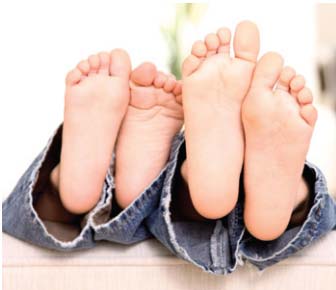Children’s Feet
Common Foot Conditions Experienced by Children

Inspecting your children’s feet regularly can help to avoid foot and gait-related complications down the road. Alberta Family Podiatry provides foot check-ups and treatment for children of all ages.
Flat feet, or the pediatric flatfoot, is one of the most common foot conditions found in toddlers and children. In infants and toddlers the arch is not developed before they learn to walk. The arch usually appears when children can stand on their toes and continues to develop through childhood.
Children with flat feet may have no painful symptoms, but you might find that they have difficulty performing physical activities or that it looks like they walk or run awkwardly. In some cases they might start experiencing cramping or pain in the feet, ankles or lower legs. Often this pain is misdiagnosed as growing pains. If pain persists you can set up an appointment with Dr. Fitzner for an assessment.
At Alberta Family Podiatry, Dr. Fitzner will perform a physical and biomechanical examination, order appropriate imaging exams, and may prescribe custom orthotics to correct alignment issues.
Plantar warts are common with children and adolescents. Plantar warts are caused by the human papilloma virus, the same virus that causes all warts, and it can be picked up with direct contact to the virus. They are common with children and adolescents because they might spend more time barefoot in public areas like the swimming pool or gym locker room at school. These warts can appear anywhere on the foot but are usually on the bottom, grown deep in the skin and can cause pain when walking or standing. There are many different treatment options but it is important to remember that the majority of wart therapies take time.
Sever’s Disease, or Calcaneal Apophysitis, is when the heel’s growth plate becomes inflamed. Severs Disease is not actually a true “disease”, but it does cause intense heel pain with increased activities. This condition usually affects children between the ages of 8-14 because their heel bone is not yet fully developed and is under repetitive stress. These stresses typically include a tight Achilles tendon, and biomechanical problems such as flatfoot or a high-arched foot. This condition can be successfully managed and pain greatly reduced by improving alignment of the feet and reducing pressure and tension to the heel bone through proper footwear, Therapy, and Custom Orthotics.